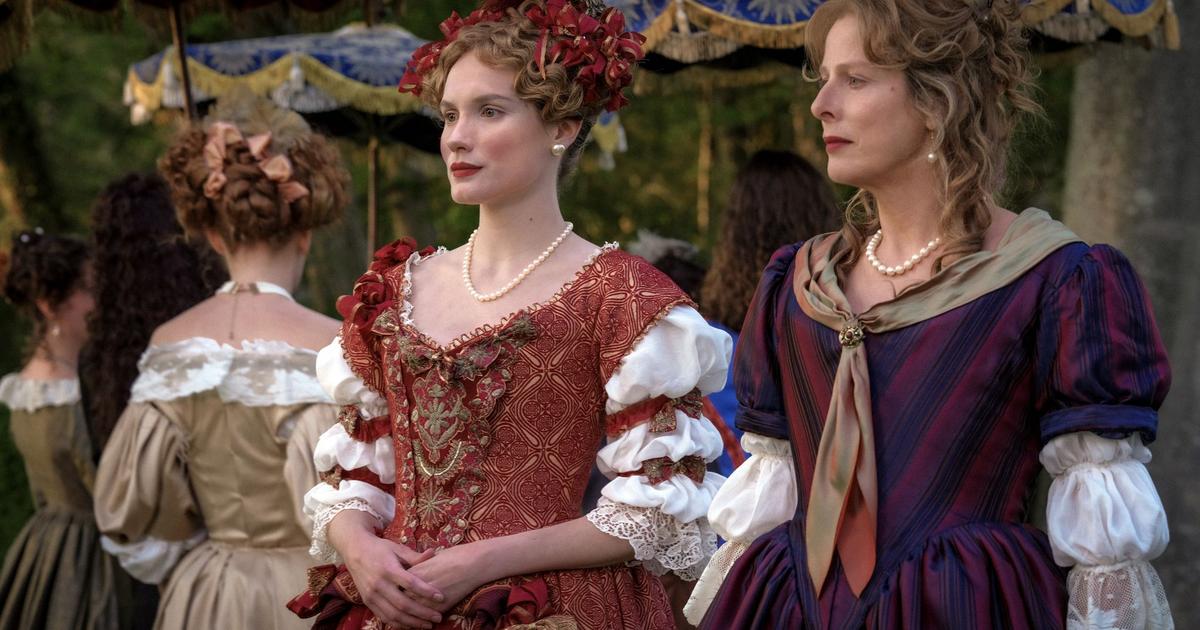The Marquise de Sévigné would not exist today without her daughter.
Published post-mortem, his letters to Françoise, who became Countess of Grignan, established his literary posterity.
They contain everything that characterizes the marquise: her vivacity, her finesse, her spirit, her intelligence but also excessive maternal love.
It is this bond between mother and daughter that director Isabelle Brocard dissects in
Madame de Sévigné
, a film which is less about the lady of the salons than the mother in the alcove, this mother who writes to her daughter:
“I have my heart and imagination full of you.
I can't think about it without crying, and I always think about it, so the state I'm in is not sustainable."
This is the same mother who, a few years earlier, said to Françoise:
“You are the prettiest girl in France”
and hatched a plan to marry her.
At the start of the triumphant Grand Siècle, the plan necessarily involves Versailles.
During a party in the gardens, the young girl catches the eye of the king but the mother is watching, who scolds the two lovebirds.
This crime of lèse-majesté will be worth the disgrace of the young Madame de Sévigné.
Which suitor will dare to tread on the king's heels?
And isn't this girl, who rejects the monarch, like her mother, formerly rebellious?
Outside of literary salons, Karin Viard rolls up her sleeves in search of the best deal.
Ana Girardot, porcelain beauty, lets herself be guided by this all-powerful woman who combines spirit and character, something she herself hardly seems to possess in the face of a precious young man who perfidiously recites to her the fable of The
Lion and the Shepherdess
.
Salvation will come from the Count of Grignan.
He will bring his name, Françoise her dowry.
“Marriage does not oblige you in any way
,” Madame de Sévigné believes it is appropriate to point out to Françoise.
“Now that he has an heir, your dad will no longer need to sleep with my daughter
,” she said to her grandson, Louis, upon discovering him as a baby.
And soon:
“Spare your health and your beauty
,” she enjoins her daughter who is having a series of pregnancies.
Two conceptions of female freedom in the 17th century are opposed.
Read alsoMadame de La Fayette, hostage to the feminization of the baccalaureate
A troubled time
“Ms. de Sévigné is both paradoxical and modern. She delivers contradictory injunctions to her daughter. She wants Françoise's independence while emphasizing that she is the prettiest girl in France. A bit like when Catherine Deneuve defends the freedom to annoy! Today, mother and daughter would be at the psychologist
,” underlines Isabelle Brocard, who indicates that she wanted to focus on the intimate and daily life of a woman of letters who tend to be confined to living rooms.
So precisely, the lounges.
She rarely films them, just gives a (too) short overview around Madame de La Fayette and La Rochefoucauld, like Lagarde and Michard.
More subtle and naughty is the treatment she reserves for the tender bond that unites Madame de Sévigné to her cousin Bussy-Rabutin, the same one who wrote to her when he found out she was suffering:
“What would I do in the world without you?”
In the background lies a troubled era, spared neither wars nor political dissensions.
Their echoes reach the Carnavalet hotel or the Château des Rochers in Brittany, refuge of the marquise.
She relaxes when her son Charles comes to see her.
A funny boy, lively like his mother and, like her, cultivating a certain idea of freedom.
So close to her but she doesn't see it, blinded by her lack of a girl.
She finds refuge at Les Rochers, enjoying the walk, the contemplation of nature, the calm, far from the Marais, its fables, its barbs and its witticisms.
Also read: “Rancé: the extreme spiritual demands of the Grand Siècle”
Isabelle Brocard describes with commendable sincerity this world in dresses and long wigs which spills out on paper, making hearts speak beneath the crunching of feathers.
Karin Viard embodies the Marquise without false note or affectation, portraying an excessive, terrified and acerbic mother, deaf to the advice of her friend Madame de La Fayette who is surprised by this insensitivity (
“Everything that does not concern you is indifferent to you”
). .
Ana Girardot, chrysalis becoming butterfly, torn between her mother and her husband, is a fragile Countess of Grignan but overcome by outbursts of revolt.
The film only covers ten years.
It contains only part of the thousand letters that the mother will send to the daughter, does not evoke the final retreat with this much-loved daughter in Grignan where the marquise is buried.
But between the intimacy of the Parisian mansion and green Brittany, it offers an elegant setting for this historical maternal confrontation and makes these textbook figures more human.
Above all, he never betrays, through anachronisms or excessive licenses, this sumptuous language which has come down to us through the grace of such a particular correspondence.
To read:
Madame de Sévigné, excessive tenderness
, by Isabelle Brocard, Fayard, 272p., €25.

